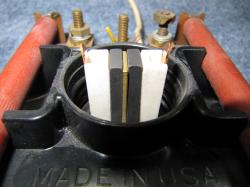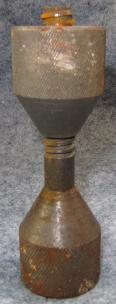
Google's trademarked company name has long since spawned a verb - people say, "Just google it!" And not just in English. In French, the verb "to google" is "googler" (pronounced "goo-glay"):
Click here to see the entire French conjugation, in all tenses. It even is conjugated in the obscure imparfait du subjonctif: "que nous googlassions", meaning "that we might have googled". What does the Académie Française think of this? After all, they're the guardians of the French language, and have historically tried to hold back all incursions by foreign words (particularly, I think, English words). Well, "googler" is not it its dictionary. Quelle surprise!
WaylandeNews Executive Director and Webmaster Kim Reichelt once reported (on Facebook) that she and her family were watching the movie "My Bodyguard", and one of the characters was looking for a part for his motorcycle. Kim's son Ben couldn't imagine why the guy didn't think of checking on eBay. Kim's husband Mark said that when Ben was told that eBay didn't exist a short time ago, the look of astonishment on his face was priceless. So it's already gotten hard to remember the days when information about almost anything, no matter how obscure, was not at our fingertips, available in seconds. It wasn't always thus. In the late sixties, while working on my doctoral thesis, I needed experimental results on the reflection of light under certain circumstances. Perhaps I could have done the experiments myself. After all, as every good graduate student should know, six months of painstaking work in the laboratory can save you an hour in the library. But instead, I tried to figure out if anyone had already done the needed research. However, since optics was not my field, and absent the Internet, which hadn't been invented yet, I was having trouble tracking down the needed references. I consulted my thesis advisor, Professor Marvin Minsky, for assistance. Being a computer expert himself, I expected him to direct me to some sort of automated search tool. However, he surprised me. He told me that when he needed information in an unfamiliar field, he first consulted a few journals in that field, not to find what he was after, but to gather the names of published researchers. Then he simply telephoned a few of them, introduced himself, and asked for their help. For the particular answer I was after, though, Professor Minsky told me that I was in luck. The professor I needed to consult was actually at MIT. He was Professor Parry Moon, Professor of Illuminating Engineering, emeritus. I called Professor Moon's telephone extension in the MIT directory, and was told by his secretary that although he had retired, he still kept office hours every Wednesday. I made an appointment. I told Professor Moon what I was after. In the blink of an eye, and without consulting any notes, he rattled off two journal citations to articles containing what I was after. He then said, "I hope you can read French". When I told him that I could, he added another citation, in the French General Electric Review, giving me the month and year the article had appeared, and adding that I could find that journal in MIT's Engineering Library. And then he gave me the information that one can never get from an automated computer search system. He said, "That's it - you won't find anything else."
About twenty years later, on March 7, 1988, I noticed Professor Moon's obituary in the Boston Globe. He had died at the age of ninety, and apparently he had been quite a colorful character. The obit noted that, "By 1942 he had begun to write a book and various papers with a former student, Domina Eberle Spencer, whom he married in 1961." 1942 was the year I was born. The Wikipedia entry on Moon and Spencer notes that, "Through their work, they became disillusioned with Einsteinian relativity and sought neo-classical explanations for various phenomena", which put them outside the mainstream of modern physics. The obit also said, "Up to the time of his death, Mr. Moon and his wife were studying electromagnetism and were still an active part of MIT's staff. Besides his wife, Mr. Moon leaves his son, Euclid Eberle Moon." Note 1 While writing this blog entry, how did I find that obituary, which I first read in the Globe in 1988? And where did all the information come from about Professor Moon's work on relativity, and about Euclid Eberle Moon? Duh - I googled for it, of course. I'm a Globe subscriber, so I can read the archives for free, but anyone can read them for a small fee. The world is now at our fingertips. Of course, for someone like me, who's interested in almost everything, and has a tendency towards A.D.D. ("Attention Deficit Disorder"), this isn't all good. I can get distracted by anything I come across, and can launch myself into a googling session that lasts hours.
What caught my eye were two notations on the bottom of the labels: GEBROCHT and NOT GEBROCHT. And being me, I just had to ask myself, "Self, what the heck does that mean?". After all, these are both kugel. Why is one GEBROCHT and one NOT GEBROCHT? Obviously, gebrocht is likely the Yiddish version of the German Past participle "gebrochen", from the verb "brechen", meaning "to break". But what does that have to do with anything? In the past, answering this question would have required a trip to the library, and I wouldn't have bothered. But now, with the Internet, and with Google, the question can be answered in a matter of seconds. And I just have to look, just because I can. Of course, the result was 45 minutes spent delving into a particularly arcane issue in Jewish dietary law. Here, try it yourself (if you click that link, a Google search on "gebrocht" will open in a separate window). The result may say "Did you mean: gebraucht" at the top, but you can ignore that. Rampant googling might not be a problem for everyone. My dilemma is that I'm curious about everything. This contributes to the impression in my family that I know everything, which I certainly don't (see my earlier blog entry Ask Larry, written by my sister Alice). I imagine many people could pass over the GEBROCHT and NOT GEBROCHT labels without being curious about them at all, but not me. Search engines can only search text, of course. They can match words, but they have a more difficult time trying to sort out meaning. Because of things like homonyms (or more properly, homographs), some searches can be quite difficult. If you're searching for a violin bow, you can't do a search on the word "bow" alone, because it has so many meanings (some pronounced the same, some differently): A violin bow
Many of our searches are on people's names. In a recent blog entry entitled Larry Black, I discussed being unable to find information about a person from my past because of his common name. Odd names can be easier to find, but they're not always as rare as you might think. My daughter Elissa has a friend from her days at Duke University named Natalia Rybczynski (who was mentioned in my blog entry Rats). It shouldn't be hard to find her with a search on Rybczynski, right? Except "Rybczynski" gets 666,000 hits! If you google [ "Lawrence Krakauer" ] (in quotes, to keep the names together), you'll get a lot of information about me. But you'll also find that although the town of Wayland, Massachusetts has only about 14,000 inhabitants, it has two residents named "Lawrence Krakauer". Not only that, but we're both MIT graduates who have worked (and in his case, is still working) in the computer industry! Actually, he's the local guy, having grown up in Weston, Massachusetts, an adjacent town. I'm an import, having grown up in Great Neck, New York, 330 Km (200 miles) away. It's purely a coincidence. We are not related, and we didn't meet until the Wayland Town Meeting of April, 2002. I looked around for a photographer to record our historic meeting, but couldn't find one. There are a substantial number of on-line reference that have information about the two of us all mixed up. I keep his phone number posted over our kitchen telephone. My middle initial is "J", and his is "A", and we're both called "Larry". Fortunately, he's a nice guy, and an upstanding citizen, so he hasn't sullied our mutual name with a criminal record. It's also hard to search on images, such as the icons you see on a computer screen. These can be a serious problem. Many icons identify themselves in English when you simply point to them with your mouse (an operation which is called "mouse-over"). But occasionally you come across an icon which offers you no such help, and in that case it can be impossible to figure out what it means. Unlike English words, you can't have an alphabetical index of icons. This is one of the disadvantages of Windows type operating systems. In some ways, I preferred DOS.
For example, when remodeling my basement, I found the odd device pictured to the right embedded above the old basement ceiling, where it had probably been for 25 years. Naturally, I wanted to know what it was. I could see that it had at one point been connected to the telephone wiring, although the wires going to it had long since been cut. To give you an idea of the size, it's 11.5 cm. high by 9 cm. wide (about 4.5 X 3.75 inches). The cylindrical Bakelite cover in the center of the device unscrewed, revealing a strange structure with dense black blocks of material sandwich between similarly shaped blocks of porcelain. A view of that structure is shown just below:  But what made me able to find it were words. As you can see if you look at it closely (by clicking on the photo two above to enlarge it), it is identified as being made by the company "Western Electric", and it contains the part number "98A". For a search engine, words are what you need. I did a Google search on: I put the search term "Western Electric" in quotation marks, so that Google would look only for pages containing those two words together. Without the quotation marks, it would find pages containing both the word "western" and the word "electric", but they wouldn't necessarily be together. This would produce a large number of irrelevant hits. I put the number "98A" in quotation marks to be sure that number-letter combination appeared exactly as written. Putting a single word in quotation marks also guarantees that the word must appear on the page found. Google used to let you put a plus sign ("+") in front of a single word to guarantee its appearance on the found page. However, they have recently eliminated that operator in favor of putting quotes around the word. This is apparently because Google is preparing to give the plus sign a different meaning, relating to their service called "Google+" ("Google Plus"). After getting the search results, I then clicked on "images" on the left side of the black bar at the top of the page, to see images brought up by the search as opposed to just any page. This brought up a very large number of image thumbnails. The upper left portion of the result is shown below:  Clearly, the very first image shown is approximately the same as the device I was looking for. This is good, because most of the images found showed entirely different things, specifically radio transmitters made by Western electric (like the image on the right above). But clicking on the first image took me to a page telling me exactly what I had (scroll down to the fifth photo). It's an old-style lightning arrestor, designed to cause a lightning strike to the telephone wires to be shunted to ground, protecting the house from fire. The black material in the strange structure in the center is actually compressed carbon. In the event of a lightning strike, the carbon vaporizes, essentially providing a path of almost zero resistance to the lightning. This type of lightning arrestor has now been replaced by a different type using a gas-filled tube. After a strike, the carbon type needs to have its carbon blocks replaced, while a gas-filled flash tube is ready for another strike.
I suppose it could have fallen off a car. On the other hand, it was near the base of a telephone pole, so it could have had something to do with the various wires mounted on the pole. I have no idea what it is. I'll call it a "thingy". It's made of solid steel, so it's heavy. It weighs 978 g. (2 pounds 2.5 ounces) and is 14 cm long (5.5 inches). The top portion (as I've shown it, standing on one end) can be unscrewed. I tried searching on things like [ heavy bolt with tapered nut ] and then selecting images, but nothing looks like my "thingy". I don't know any way to search for something like this, other than to post a picture on a webpage like this one, and see if anyone recognizes it. Of course, there aren't all that many people reading my blog. Meanwhile, it makes a decent paperweight. Do you know what it is? There is a web site called TinEye that you can use to try to identify an image found on the Internet. It will search the Internet for other copies of the same image (possibly of a different resolution), and one of the other sites containing the image may better identify it for you. But the picture of Mr. Thingy is one I took myself, so TinEye can't find it (I did the search before posting this page). How did I find out about TinEye? With Google, of course. I googled [ identify images ].
  Note 1: Euclid Moon still seems to be carrying on his father's work - here's one of his 1993 papers on an alternative interpretation of the Michelson-Morley experiment (PDF file). As is frequently the case, the paper has an abstract at the top of the first page. It also has the same abstract in French on the last page - perhaps, like his father, Euclid Moon speaks French. [return to text] Note 2:
Ever hear the nine-word summary of all Jewish holidays? "They tried to kill us, we won, let's eat." Well, not Yom Kippur - you don't eat on that one. [return to text]
 |
 After leaving his office, I went up to the Barker Engineering Library in MIT's Building Ten. That's the center of the campus - the Barker library is what's under the dome. And there I found the articles, in precisely the journals and issues specified by Professor Moon.
After leaving his office, I went up to the Barker Engineering Library in MIT's Building Ten. That's the center of the campus - the Barker library is what's under the dome. And there I found the articles, in precisely the journals and issues specified by Professor Moon.


